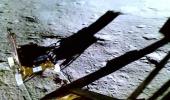Three Wednesdays ago, on August 23, Chandrayaan-3 landed close to the Moon's south pole, making space history.
Over the next 10 days, Chandrayaan's lander Vikram and rover Pragyan sent images of the lunar surface to ISRO headquarters in Bengaluru.
Glimpses of what the historic Chandrayaan Mission discovered on the dark side of the Moon.
Glimpses of the far side of the moon captured by Chandrayaan-3.
Before landing on the moon Chandrayaan-3 took a few pictures.

Mare Humboldtianum is a lunar mare (a large, level basalt plain on the surface of the moon, appearing dark by contrast with highland areas).
It is situated between near (visible) and far sides of the Moon, like a link between the known and unknown. All photographs: Kind courtesy ISRO

Bel'kovich is the large ring in the centre with the 87 km Hayn to its northwest.

Hayn is a lunar impact crater that lies next to the northeast limb of the Moon.

Boss L is a lunar impact crater that is located along the northeast rim of the Moon's near side.
While landing on the moon.

When Chandrayaan-3 landed on the Moon.

After the landing.

The Pragyan Rover exits the Vikram Lander and takes a moon walk.



Chandrayaan-3's Lander Vikram and Rover Pragyan begin their mission.
The first observations from the Chandra's Surface Thermophysical Experiment (ChaSTE) payload onboard the Vikram Lander.
The ChaSTE is used to measures the temperature profile of the lunar topsoil around the pole, to understand the thermal behaviour of the moon's surface.
It has a temperature probe equipped with a controlled penetration mechanism capable of reaching a depth of 10 cm beneath the surface.
The probe is fitted with 10 individual temperature sensors.
Another payload on board is the Lunar Seismic Activity (ILSA), to measure seismicity around the landing site.

The Laser-Induced Breakdown Spectroscopy (LIBS) confirms the presence of Sulphur on the lunar surface through unambiguous in-situ measurements.
The LIBS instrument on board the Chandrayaan-3 rover made the first-ever in-situ measurements on the elemental composition of the lunar surface near the south pole.
These in-situ measurements unambiguously confirm the presence of Sulphur in the region, something that was not feasible by the instruments on board the orbiters.

The Alpha Particle X-ray Spectrometer (APXS) on board the Pragyan Rover detects the presence of minor elements.
It helps to find what the lunar soil and rocks are made of in the south polar region at the landing site and how different it is from other highland regions on the Moon.

ILSA listened to the movements around the landing site.
The Radio Anatomy of Moon Bound Hypersensitive ionosphere and Atmosphere -- the Langmuir Probe(RAMBHA-LP) -- on board Chandrayaan-3 measured near-surface plasma content.
The lander and rover are currently in sleep mode. Await their awakening around September 22, 2023.
Text source: Kind courtesy ISRO
Feature Presentation: Ashish Narsale/Rediff.com











